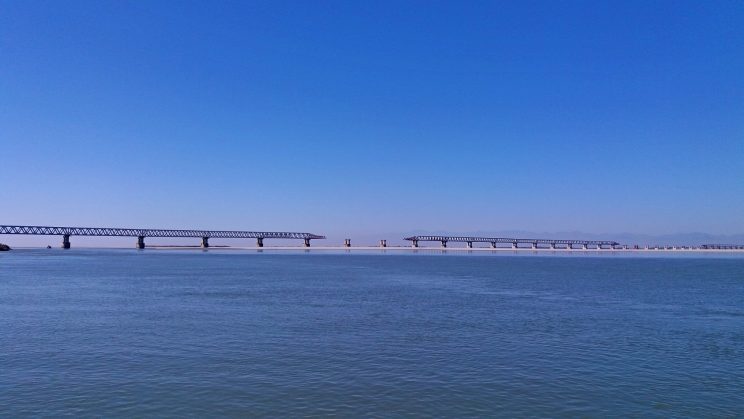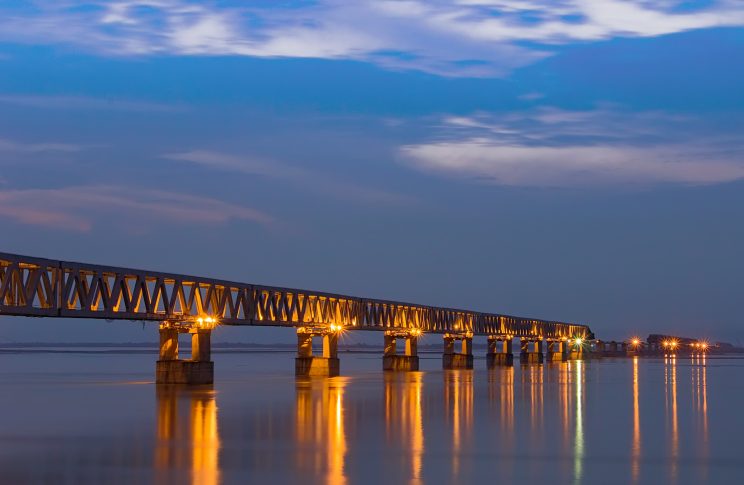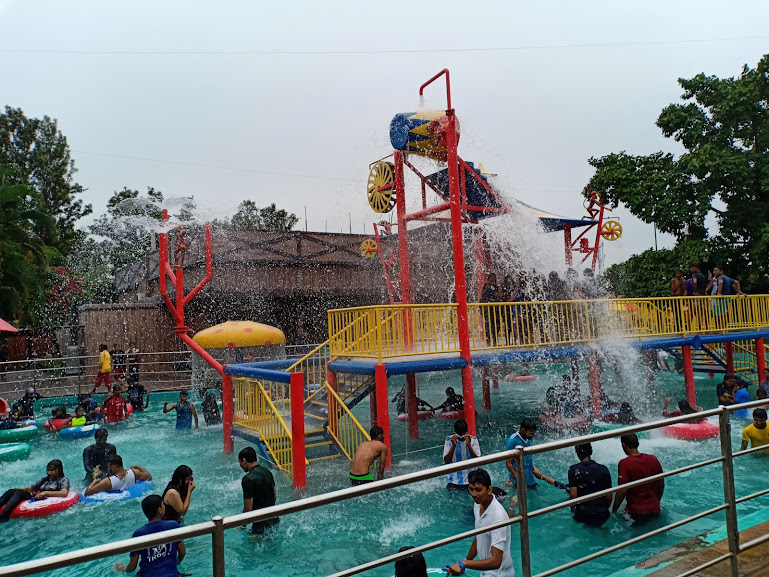Recently I read in the news that India’s longest Rail and Road bridge is coming up in Assam. This is the Bogibeel Bridge which is going to be inaugurated by Prime Minister Narendra Modi on December 25, 2018 as a Christmas and New Year gift to the entire North East. But what is the real story of the making of the Bogibeel bridge? Read on to know more!
By Vikramjit Kakati – Own work, CC BY-SA 4.0, Link
Bridging River Brahmaputra has always been a daunting task. The river has been traditionally considered extremely difficult for bridging due to various reasons including it’s ferocious and unpredictable behaviour, high currents and turbulent waters, widespread erosion of the banks, very short working period and high seismicity and remoteness of the area. On top of that, the construction is only possible 4 months in a year due to the heavy monsoon and melting of glaciers in summer.
With the width ranging from 1.2 km to 18 km, Brahmaputra river has been bridged 4 times in past. Hindustan Construction Company (HCC) holds the distinction of being the only company which has built two of these bridges and has now built the 5th bridge too at Bogibeel, near Dibrugarh.
HCC has always been at the forefront of building bridges in Assam as they built the Saraighat bridge way back in 1962 near Guwahati. This bridge was opened to traffic in April 1962 by the then Prime Minister Jawaharlal Nehru.
HCC was pivotal in also constructing the Kolia Bhomora Setu at Tezpur which is a pre-stressed concrete road bridge that connects Sonitpuron on the north bank with Nagaon district on the south bank. The length of this bridge is 3015 m, and its construction went on from 1981 to 1987. This was very important bridge in the history of Assam.
HCC in joint venture with DSD Brouckenbau GmbH, Germany and VNR Infrastructures Ltd received order from Northeast Frontier Railway to construct the superstructure of Bogibeel Rail-cum-road Bridge in November 2011.
It was not an easy task to build the Bogibeel bridge. HCC aced it by doing a lot of things very innovatively. HCC team came-up with a solution of pulling the steel trusses with a set of jacks and winches on the pillars. This eliminated the need to enter the river, which was often turbulent during monsoons. Besides, it also ensured safer working conditions, precluded the mobilisation of giant setup on either side of the river having a width of 4.8 km and accelerated the pace of the project.

RVR Kishore, project director of the Hindustan Construction Company Ltd., recently mentioned that the location of the Bogibeel Bridge falls in Seismic Zone-V. In Indian history, Zone V has been most vulnerable to earthquakes with magnitudes in excess of 7.0. In order to offer good stability to the heavy spans (1700 MT), they are provided with seismic restrainers. This ensures that the Bogibeel bridge can withstand earthquake up to magnitude of 7 on the Richter scale and beyond. This is really good planning by HCC team!
Normally in a steel bridge construction, bolts & rivets are used, which needs periodic replacement due to shear failure over traffic loads. Construction of trusses using welding makes the connection between the components a permanent one, thereby eliminating the above failures. Welded bridge not only reduced the maintenance cost but also adds to the longevity of the superstructure. It is estimated that Bogibeel Bridge is durable and serviceable for next 120 years!
Railways have traditionally used steel rocker-roller bearings for bridges with larger spans. For the Bogibeel Bridge, the initial plan was to use Pot-PTFE bearing with metallic pins and guide bearings. However, it was found out that the size of bearing required for taking the anticipated load cannot be accommodated in the pier cap, hence Spherical Bearings have been used.
The superstructure of Bogibeel Bridge has been constructed using a special grade copper-bearing steel plates in order to reduce corrosion. The average annual relative humidity in Bogibeel is 90% which goes up to 96% to 97%. To further reduce corrosion due to the excessive humidity, a complex Corrosion Protection System specific to different components of the bridge has been implemented during the construction of the bridge.
Overall, Hindustan Construction Company (HCC) has created history by creating a modern marvel of engineering – India’s longest Rail and Road bridge – Bogibeel Bridge in Assam!









